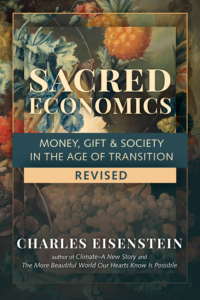Climate — A New Story
Chapters
Chapter 8: Regeneration
Healing the Soil
In chapter 4 I wrote, “We are called to visit deep questions like ‘What are we here for?’ ‘What is humanity’s right role on earth?’ ‘What does the earth want?’” I wrote, “In the new relationship …, whenever we take from the earth, we seek to do so in a way that enriches the earth. We aren’t unconscious of our impact, nor do we seek to minimize our impact. We seek to make a beautiful impact that serves all life.”
This is the sponsoring precept of a growing movement that has adopted the adjective “regenerative” to describe its practices. The best known is regenerative agriculture.
Regenerative agriculture comprises an array of techniques that rebuild soil, water, and biodiversity. Typically, it uses cover crops and perennials so that bare soil is never exposed, fosters synergistic relationships among multiple food and nonfood crops, restores the natural water cycle, and grazes animals in ways that mimic herd animals in nature. In focusing on soil, it carries the original spirit of organic agriculture. The term “organic” was adopted by its preceptor, J. I. Rodale, in reference to the organic (carbon-containing) molecules that form living soil. He understood that soil is more than a mixture of chemicals. Unfortunately, the term has lost that original meaning, perverted to the point now where the USDA allows organic labeling on hydroponic vegetables that are grown in no soil at all. That is why I am not using the term “organic agriculture” here, although the regenerative practices I will describe are indeed organic in the true spirit of Rodale.
Regenerative practices have received attention recently for their ability to quickly sequester large amounts of carbon. As the reader knows by now, I think it is a mistake to evaluate technologies based on a single quantity like carbon, but in this case carbon corresponds to the building of topsoil. Topsoil is the foundation of life on land; it is the living layer of Earth’s surface. Regenerative farmers and permaculture farmers understand that all beings on a farm, including human beings, will thrive when the soil thrives.
One promising technique to rebuild soil health is called management-intensive rotational grazing (MIRG), which seeks to raise animals in a way that mimics their role on natural grasslands. Unless you come from a culture that still practices traditional nomadic animal husbandry, when you think of pastured animals you probably picture an expanse of grass dotted with cows or sheep. That picture is far from anything you would see in a healthy ecosystem. Healthy ecosystems include predators for whom a field of scattered sheep would amount to an all-you-can-eat buffet. That is why herbivores gather in large herds for protection, intensively grazing an area and then moving on. That is what MIRG replicates.
As in natural grasslands, large concentrated herds of herbivores maintain grassland health and build soil. The herd eats mostly the sweet grass tops and tramples down and manures the rest of the plants before they can eat them down to the roots. This allows the grass to quickly recover after the herd moves on. Not only is the soil protected from erosion by the thick layer of trampled vegetation, but the damage causes the plants to send sugars into the roots, generating the rich exudates that, along with the manure and decaying plant matter, nourish soil biota. The soil biota, especially earthworms, increases the permeability of the soil, making it into a sponge for rain. The hooves of the animals aid that process by piercing the soil surface and making indentations that trap water.
When practiced on degraded land, MIRG brings it back to life. Dried-up springs begin flowing again, brown landscapes turn green, birds and biodiverse wildlife return, seasonal streams start flowing year-round, and depleted soils recover tilth and depth.
The most influential practitioner of management-intensive rotational grazing is Allan Savory, a Zimbabwean biologist and farmer who has inspired and taught his methods to farmers throughout sub-Saharan Africa, North America, South America, and Australia. His TED talk shows stunning before-and-after photos of land restored through the practice, which he calls Holistic Grazing.[1]
His claims have engendered considerable controversy.[2] I tend to believe the pro side: first, because the critics attack an uninformed caricature of the practices Savory promotes; second, because there has been a veritable groundswell of farmers and ranchers using the method and sharing anecdotes throughout the alternative farming media. However, actual proof is hard to obtain, in large part because of a paucity of hard quantitative data. In addition to the difficulty in measuring soil carbon, MIRG is not a standardized process, but must vary according to local conditions, even from one farm or valley to the next. That is the point in Savory’s use of the term “holistic.” The right practices can be determined only in intimate relationship to the land.
Although carbon sequestration data for MIRG practices is scarce, recent studies point to amounts that are much greater than most scientists previously believed. A 2014 study at the University of Georgia measured annual per-hectare increases in soil carbon at 8 tons per year on farms converted from row cropping to intensively managed grazing.[3] Water retention also rose by a third. The world uses about 3.5 billion hectares of land for pasture and fodder crops. Converting just a tenth of that land to MIRG practices would (using the 8 tons figure above) sequester a quarter of present emissions. (MIRG also reduces methane emissions by as much as 22 percent compared to conventional meat production.)[4]
Individual farmers report much higher carbon sequestration figures. One of the most famous regenerative farms is Brown’s Ranch in North Dakota, which used holistic grazing practices to raise carbon levels from 4 percent to 10 percent in the span of six years—equivalent to 20 tons of carbon per hectare per year.[5] Its rainwater absorption capacity also rose from a half inch an hour—entailing massive runoff—to eight inches per hour.[6] The rancher/farmer Gabe Brown and his family do not rely on managed grazing alone. They use a complex mix of cover crops, and multilayered intercropping as well: picture radishes and turnips growing under a canopy of sunflowers. They deliberately cultivate plants with a variety of root depths. The diverse, perennial vegetation nourishes high insect biodiversity, providing natural pest control—the farm has no problems with the corn root worm that plagues neighboring farms and is America’s number one agricultural pest. Despite using no pesticides and no fertilizers, the farm yields 25 percent more corn than the county average, at a much lower cost per bushel.
Like grazing, regenerative horticulture also bears tremendous promise to draw down carbon, using similar principles. It avoids plowing or any other form of soil disturbance, favoring cover crops that are crimped or cut to feed soil biota and become the next layer of humus. According to research at the Rodale Institute, if instituted universally, organic regenerative techniques practiced on cultivated land could offset over 40 percent of global emissions, while practicing them on pastureland could offset 71 percent.[7] The potential for land-based CO2 reduction is over 100 percent of current emissions—and that doesn’t even include reforestation and afforestation.
Another impressive approach is Syntropic Agriculture, also known as regenerative analog forestry, developed in Brazil by Ernst Gotsch. In 1984 he purchased a huge 500-hectare farm that had been severely degraded due to clear-cutting, a manioc plantation on hillsides, and other abuse. It was known locally as “the dry land.” Gotsch restored the land to health by mimicking ecological succession, by applying companion planting, and through heavy “chop-and-drop” pruning to build soil organic matter. Thirty years later, the land has been transformed. Fourteen dry springs have come back to life, streams flow all year round, the biodiversity of the original Atlantic coastal rainforest has returned, temperatures have cooled in the micro-region, and rainfall has increased. And the farm produces abundant food, lumber, and other products, including what some consider the world’s highest quality cacao beans,[8] all without irrigation, pesticides, or fertilizers of any kind. As one worker there explains, food production rides on top of natural forest succession instead of fighting it. With each successive harvest, the soil is richer than the year before.[9] Projects inspired by his model have taken off throughout Brazil, and have spread to Australia and other places as well.
Gotsch did not develop this method with the goal of drawing down carbon, but according to a study by Cooperafloresta Brazil, his method sequesters about 10 tons/hectare of carbon depending on where it is in the successional cycle.[10] I mention this mainly to reiterate that the ecosystems-centered view of this book does not contradict the requirements of the standard climate narrative. Nor, however, does it depend on that narrative for its motivation—in the water frame and the biodiversity frame, regenerative practices are even more appealing.
End Notes
[1] Savory (2013).
[2] For a taste of the controversy, see Lovins (2014).
[3] Machmuller et al. (2015).
[4] DeRamus et al. (2003).
[5] Hawken (2017), 73.
[6] This figure and those following are from Ohlson (2014).
[7] Rodale Institute (2014).
[8] Taguchi (2016).
[9] See “Life in Syntropy,” a short film about the farm and Syntropic Agriculture on Vimeo or YouTube.
[10] Cooperafloresta (2016), cited in Sendin (2016).






